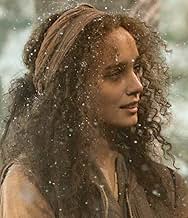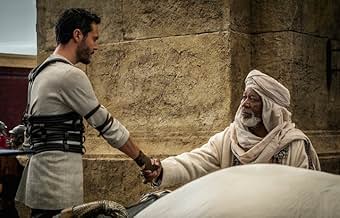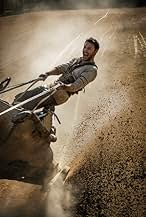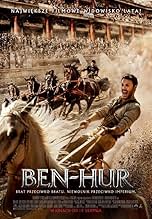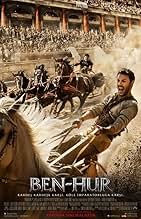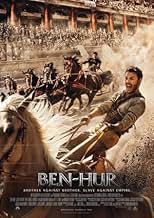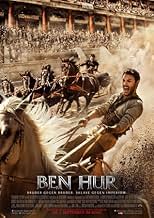AVALIAÇÃO DA IMDb
5,7/10
49 mil
SUA AVALIAÇÃO
Judá Ben-Hur, um príncipe falsamente acusado de traição por seu irmão adotivo, retorna à sua terra natal depois de anos no mar em busca de vingança, mas encontra a redenção.Judá Ben-Hur, um príncipe falsamente acusado de traição por seu irmão adotivo, retorna à sua terra natal depois de anos no mar em busca de vingança, mas encontra a redenção.Judá Ben-Hur, um príncipe falsamente acusado de traição por seu irmão adotivo, retorna à sua terra natal depois de anos no mar em busca de vingança, mas encontra a redenção.
- Direção
- Roteiristas
- Artistas
- Prêmios
- 2 vitórias e 3 indicações no total
Sofia Black-D'Elia
- Tirzah Ben-Hur
- (as Sofia Black D'Elia)
Haluk Bilginer
- Simonides
- (as Haluk Biligner)
Yasen Zates Atour
- Jacob
- (as Yasen Atour)
Gabriel Lo Giudice
- Elijah
- (as Gabriel Farnese)
Jarreth J. Merz
- Florus
- (as Jarreth Merz)
- Direção
- Roteiristas
- Elenco e equipe completos
- Produção, bilheteria e muito mais no IMDbPro
Avaliações em destaque
Huston conveyed emotion, remorse, rage, resignation and relief with depth and the effortlessness of truth: each won by long years of pain or the grace of an instant. A sort of well, dare I say 'goodness' seems to emanate from the man. He is blithely naive, callow, filled with talent and care for his fellow man and beasts. A mantle of grace rests upon him....you can feel it.
I would give his performance 10 stars. In fact, I do.
The film, however...
I do not like the inclusion of contemporary music in historical settings. It grates at the suspension of disbelief required to be lost in the time and place being brought to life. It holds the entire narrative up against a shadow puppet screen and says 'remember, this isn't real.' That's not what I want. Contemporary music plays at the close of the film, I recall.
Also, the costuming.... they didn't get away with the use of polyester fabrics ~ particularly with metallic elements. They could be seen and were glaring anachronisms, particularly in the women's clothing and in the beginning scenes. Again, jarring to one wishing to believe he is indeed looking upon the time roughly corresponding with the beginning of our calendar system.
The costuming recovers, however. Huston's tunics and attire are flawless. But what about Freeman's Tuareg clothing? Was he a Moor? A Tuareg? An Amazight? They might have made it more clear which sort of African he represented.
The film is worth seeing. It is stirring. It touches the depths of suffering and sorrow and leaves an impression if not a few tears.
I would give his performance 10 stars. In fact, I do.
The film, however...
I do not like the inclusion of contemporary music in historical settings. It grates at the suspension of disbelief required to be lost in the time and place being brought to life. It holds the entire narrative up against a shadow puppet screen and says 'remember, this isn't real.' That's not what I want. Contemporary music plays at the close of the film, I recall.
Also, the costuming.... they didn't get away with the use of polyester fabrics ~ particularly with metallic elements. They could be seen and were glaring anachronisms, particularly in the women's clothing and in the beginning scenes. Again, jarring to one wishing to believe he is indeed looking upon the time roughly corresponding with the beginning of our calendar system.
The costuming recovers, however. Huston's tunics and attire are flawless. But what about Freeman's Tuareg clothing? Was he a Moor? A Tuareg? An Amazight? They might have made it more clear which sort of African he represented.
The film is worth seeing. It is stirring. It touches the depths of suffering and sorrow and leaves an impression if not a few tears.
Ben Hur has been a seminal film in the different eras in which it appeared. The 1925 silent film was produced by Irving Thalberg, Louie Mayer and Sam Goldwyn and starred Ramon Navarro and Francis X Bushman, two of the biggest stars of the time. It cost $3.9 million and was the most expensive film to that date. It was a big success at the box office and with critics.
The 1959 film was directed by William Wyler who worked on the 1925 film. As with the previous film, it was the most expensive to date ($15 million) and also had big name stars, most notably Charlton Heston. It became the second highest grossing film of all time, behind GWTW, and received high critical praise, winning an unprecedented 11 Oscars.
What about this latest version. It doesn't exactly have big name stars. Jack Huston plays Ben Hur and Toby Kebbell plays Messala. It's directed by Timur Bekmambetov who's best known for "Abraham Lincoln: Vampire Hunter". The box office was pretty poor, not earning back the $100 million production costs.
The film bears only slight resemblance to the book. When you consider how successful the book was, the reason to vary seems questionable.
All things considered this is a far inferior film to either the 1959 or the 1925 version. Some of the scenes are well done (sea battle, chariot race) but not to an outstanding level as the previous versions had done.
The 1959 film was directed by William Wyler who worked on the 1925 film. As with the previous film, it was the most expensive to date ($15 million) and also had big name stars, most notably Charlton Heston. It became the second highest grossing film of all time, behind GWTW, and received high critical praise, winning an unprecedented 11 Oscars.
What about this latest version. It doesn't exactly have big name stars. Jack Huston plays Ben Hur and Toby Kebbell plays Messala. It's directed by Timur Bekmambetov who's best known for "Abraham Lincoln: Vampire Hunter". The box office was pretty poor, not earning back the $100 million production costs.
The film bears only slight resemblance to the book. When you consider how successful the book was, the reason to vary seems questionable.
All things considered this is a far inferior film to either the 1959 or the 1925 version. Some of the scenes are well done (sea battle, chariot race) but not to an outstanding level as the previous versions had done.
By design, this is a very ambitious project! Not only because it's a 100 million blockbuster. Would the author of the Russian "Patrols" ever dream that he would be entrusted in Hollywood to shoot "Ben-Hur"?! A biblical novel was written by American General Hugh Wallace in 1880. The first feature film was made in 1925 - the most expensive film in the history of silent films. But the Oscar-winning film adaptation of 1959, which collected a total of 11 gold figurines, became truly grandiose. It was the heyday of the peplum genre.
Reviving with Ridley Scott's Gladiator, it's on the decline again. And now Timur Bekmambetov, having taken the post of director of the new "Ben-Hur", is forced to solve the following tasks: to rehabilitate himself for the failure of the film "Lincoln: Vampire Hunter", to adequately paint his first historical canvas and, most importantly, not to repeat the classic painting by William Wyaler. Therefore, our director constantly insisted that this was not a remake, but only another adaptation of the best-selling novel. But is it?
Despite significant discrepancies with the literary source, the film resembles just the same remake, but in its own way it beats certain scenes. "In your own way" - does not mean inventive! Bekmambetov's main problem is that, trying to modernize the biblical story, he, firstly, chooses a completely inappropriate shooting style, and secondly, does not pay due attention to the "historicity" of what is happening. What are we used to seeing in peplum? Panoramic wide shots, smooth narration and lengthy scenes.
This is how the viewer sees the scale, feels epic, lives with the characters for a whole life on the screen and studies each frame in detail, full of props and scenery. A shaking camera was also used here, which created the feeling of an ongoing earthquake. What is interesting in historical films? Study the environment. But it is difficult to do this when the picture is unstable most of the time and you get into your eyes - either part of the head instead of the face, then part of the body instead of the body! A steep installation so generally sometimes disorients in space. Static panoramic shots were still present (and even with extras), but they were outrageously few.
An attempt to bring the times of Jesus Christ closer to modern realities looked extremely inappropriate. After all, this was expressed not through the idea - Christian morality (relevant at all times!), but through the subject environment. In the stylish shirts Ben-gur, in which he walked around, it would not be a shame to appear in a nightclub of the 21st century, and the dreadlocks of his mentor Ilderim (played by Morgan Freeman) still raise questions - who curled them for him? This is a kind of glamorization of archaic things and even mores. It's hard to believe the Prince of Judea (Jack Huston) and the Roman tribune (Toby Kebbell) are authentic, more like modern-day majors meeting at a party in the ancient Roman spirit. The archaism of their types is still convincing, which cannot be said about their characters. Russian dubbing also throws up riddles - for some reason, everyone calls the main protagonist Judah? But he is Judas Ben-Hur. It was impossible to come to terms with this throughout the film.
As already mentioned, Bekmambetov changed his story in relation to the novel and, in particular, to the 1959 film. The main plot has remained the same. The picture tells us about the confrontation between the two named brothers, Judas and Messala, who later became sworn enemies. One for a free Judea, the other for the rule of Rome. Innocently convicted Ben-Hur gets into the galleys and only miraculously got out of there - he is looking for an opportunity to take revenge on Messala. The background to all this is the emerging Christianity in Judea and the preaching of Jesus Christ, with whom our hero repeatedly met in the most difficult moments of his life. Bekmambetov not only distorted the plot, he also simplified it, which made the dramaturgy very lame. This is a hastily retold Wallace novel with minor additions and directorial emphasis. If in the novel Judas (Judas) overcame a crisis of faith, here he faced only one of the postulates of Christian teaching - to forgive one's neighbor. In Bekmambetov's version, he discovers in himself only an inner attachment to his brother, while the true prince of Judea connects his fate with his native people.
In general, Ben-Hur came out as a rather weak and spineless peplum.
The atmosphere is dead, the characters are flat (perhaps one of the worst images of Jesus Christ in cinema!), the pseudo-documentary style of filming, jagged editing and uneven narration create only confusion; there is no pomp and pomposity ("The Eternal City" in all its glory was never shown to us), and calm elegiac music with a guitar only lulled. The famous chariot racing scene will remain the most famous only in the picture of William Wyaler. As his film will remain famous.
Reviving with Ridley Scott's Gladiator, it's on the decline again. And now Timur Bekmambetov, having taken the post of director of the new "Ben-Hur", is forced to solve the following tasks: to rehabilitate himself for the failure of the film "Lincoln: Vampire Hunter", to adequately paint his first historical canvas and, most importantly, not to repeat the classic painting by William Wyaler. Therefore, our director constantly insisted that this was not a remake, but only another adaptation of the best-selling novel. But is it?
Despite significant discrepancies with the literary source, the film resembles just the same remake, but in its own way it beats certain scenes. "In your own way" - does not mean inventive! Bekmambetov's main problem is that, trying to modernize the biblical story, he, firstly, chooses a completely inappropriate shooting style, and secondly, does not pay due attention to the "historicity" of what is happening. What are we used to seeing in peplum? Panoramic wide shots, smooth narration and lengthy scenes.
This is how the viewer sees the scale, feels epic, lives with the characters for a whole life on the screen and studies each frame in detail, full of props and scenery. A shaking camera was also used here, which created the feeling of an ongoing earthquake. What is interesting in historical films? Study the environment. But it is difficult to do this when the picture is unstable most of the time and you get into your eyes - either part of the head instead of the face, then part of the body instead of the body! A steep installation so generally sometimes disorients in space. Static panoramic shots were still present (and even with extras), but they were outrageously few.
An attempt to bring the times of Jesus Christ closer to modern realities looked extremely inappropriate. After all, this was expressed not through the idea - Christian morality (relevant at all times!), but through the subject environment. In the stylish shirts Ben-gur, in which he walked around, it would not be a shame to appear in a nightclub of the 21st century, and the dreadlocks of his mentor Ilderim (played by Morgan Freeman) still raise questions - who curled them for him? This is a kind of glamorization of archaic things and even mores. It's hard to believe the Prince of Judea (Jack Huston) and the Roman tribune (Toby Kebbell) are authentic, more like modern-day majors meeting at a party in the ancient Roman spirit. The archaism of their types is still convincing, which cannot be said about their characters. Russian dubbing also throws up riddles - for some reason, everyone calls the main protagonist Judah? But he is Judas Ben-Hur. It was impossible to come to terms with this throughout the film.
As already mentioned, Bekmambetov changed his story in relation to the novel and, in particular, to the 1959 film. The main plot has remained the same. The picture tells us about the confrontation between the two named brothers, Judas and Messala, who later became sworn enemies. One for a free Judea, the other for the rule of Rome. Innocently convicted Ben-Hur gets into the galleys and only miraculously got out of there - he is looking for an opportunity to take revenge on Messala. The background to all this is the emerging Christianity in Judea and the preaching of Jesus Christ, with whom our hero repeatedly met in the most difficult moments of his life. Bekmambetov not only distorted the plot, he also simplified it, which made the dramaturgy very lame. This is a hastily retold Wallace novel with minor additions and directorial emphasis. If in the novel Judas (Judas) overcame a crisis of faith, here he faced only one of the postulates of Christian teaching - to forgive one's neighbor. In Bekmambetov's version, he discovers in himself only an inner attachment to his brother, while the true prince of Judea connects his fate with his native people.
In general, Ben-Hur came out as a rather weak and spineless peplum.
The atmosphere is dead, the characters are flat (perhaps one of the worst images of Jesus Christ in cinema!), the pseudo-documentary style of filming, jagged editing and uneven narration create only confusion; there is no pomp and pomposity ("The Eternal City" in all its glory was never shown to us), and calm elegiac music with a guitar only lulled. The famous chariot racing scene will remain the most famous only in the picture of William Wyaler. As his film will remain famous.
Last time I watched the Ben-Hur with Charlton Heston the thought did not cross my mind that perhaps the world needed another version of the story directed by the guy who brought us Abraham Lincoln: Vampire Hunter and that weird movie where they make bullets bend.
Anyway, the Heston version is one of my favorite movies. I saw it when I was 8 and two times when I was about 20. I love it and quote it all the time.
But this is not a review of that version because (surprise!) it is not that version. This is a review of the 2016 version and I don't feel it is fair to give this movie a bad rating simply because it was an unnecessary remake. In case you are wondering, this is the sixth version of Ben-Hur.
The story follows Judah Ben-Hur, a Jewish prince in Jerusalem at the time of Christ, and his adopted Roman brother Massala. They love each other but they get in the middle of an attempted assassination on a Roman leader and wind up on opposing sides. They both feel they are in the right, get in a very sticky situation, and thus begins an 5 year journey of survival, revenge, forgiveness.
I liked the movie. The chariot race was thrilling. I was worried about it because the trailer showed a scene which an obvious CGI horse running through the stands. To my delight that was the only part that really used a CGI horse (that I could tell, anyway). The rest of the race was intense even though I already knew how it was going to end.
The movie focuses very heavily on the relationship between Massala and Judah as well as Massala and the rest of the Hur family. Massala's intentions and actions were understandable and he wasn't just some evil man who betrayed his family.
The main actors and actresses do a good (not great) job. I felt Morgan Freeman may have phoned it in a little, but he delivered one of my favorite lines of the movie. My favorite actors were the slave drivers on the galley along with the drummer. They have small roles but I loved them.
I didn't care for the Jesus scenes though. He is a hard character to portray, and I just didn't like it when he spoke. I'm probably picky, but I would have preferred to hear him speak in King James English or not at all (like in the Heston version). I just felt something was off with the scenes and they could have been more powerful.
Overall, I felt it was a pretty good movie that succeeds in many aspects chiefly with the themes of revenge/forgiveness and delivers one exciting race. It's not perfect but a good movie overall.
Anyway, the Heston version is one of my favorite movies. I saw it when I was 8 and two times when I was about 20. I love it and quote it all the time.
But this is not a review of that version because (surprise!) it is not that version. This is a review of the 2016 version and I don't feel it is fair to give this movie a bad rating simply because it was an unnecessary remake. In case you are wondering, this is the sixth version of Ben-Hur.
The story follows Judah Ben-Hur, a Jewish prince in Jerusalem at the time of Christ, and his adopted Roman brother Massala. They love each other but they get in the middle of an attempted assassination on a Roman leader and wind up on opposing sides. They both feel they are in the right, get in a very sticky situation, and thus begins an 5 year journey of survival, revenge, forgiveness.
I liked the movie. The chariot race was thrilling. I was worried about it because the trailer showed a scene which an obvious CGI horse running through the stands. To my delight that was the only part that really used a CGI horse (that I could tell, anyway). The rest of the race was intense even though I already knew how it was going to end.
The movie focuses very heavily on the relationship between Massala and Judah as well as Massala and the rest of the Hur family. Massala's intentions and actions were understandable and he wasn't just some evil man who betrayed his family.
The main actors and actresses do a good (not great) job. I felt Morgan Freeman may have phoned it in a little, but he delivered one of my favorite lines of the movie. My favorite actors were the slave drivers on the galley along with the drummer. They have small roles but I loved them.
I didn't care for the Jesus scenes though. He is a hard character to portray, and I just didn't like it when he spoke. I'm probably picky, but I would have preferred to hear him speak in King James English or not at all (like in the Heston version). I just felt something was off with the scenes and they could have been more powerful.
Overall, I felt it was a pretty good movie that succeeds in many aspects chiefly with the themes of revenge/forgiveness and delivers one exciting race. It's not perfect but a good movie overall.
Hollywood remakes. For every Ocean's 11, there's 10 Willy Wonkas. So here we are saddled with another previously untouchable classic getting a slickly made, soulless studio remake. But is it fair to judge it just because it's a remake? Or does it succeed on its own merits?
I love the William Wyler '59 original classic, and watch it often. The quoteable lines are brilliant. "Your eyes are full of hate, 41. That's good. Hate keeps a man alive". Charlton Heston is great as Ben Hur. And that chariot race is one of the greatest action spectacles ever put on the silver screen.
I just can't envisage myself re- watching this. The effects are impressive, but any tosspot on a computer can conjure up digitally creative wowzers, so that is no selling point. And the action is predictably impressive, but it's so stagnant, slick and with no standout unforgettable moment. Jack Huston brings nothing new to the role of Ben- Hur, and Morgan Freeman clearly has a new flat screen TV to pay for, so he shows up to phone it in.
For the past 16 years we've seen sword & sandal epics go from fun genre revival (Gladiator) to moribund cliché (Hercules, 300 Rise of the Empire). In fact Rodrigo Santoro (Xerxes from 300) shows up as Jesus Christ this time. From Persian tyrant to Jewish prophet, now that's an improvement.
I left the cinema knowing that I'll forget about this in 3 weeks. Remakes can improve on the original (The Fly, The Thing, the '59 Ben-Hur is itself a remake of an early silent B&W version). But you risk falling into trap of being so slavishly loyal to the original that to redo the film becomes pointless (Pyscho).
I can't recommend paying full cinema price. Stay at home and watch the '59 original. On the small screen, Chuck Heston commands a stronger presence than anyone in this large screen bore.
I love the William Wyler '59 original classic, and watch it often. The quoteable lines are brilliant. "Your eyes are full of hate, 41. That's good. Hate keeps a man alive". Charlton Heston is great as Ben Hur. And that chariot race is one of the greatest action spectacles ever put on the silver screen.
I just can't envisage myself re- watching this. The effects are impressive, but any tosspot on a computer can conjure up digitally creative wowzers, so that is no selling point. And the action is predictably impressive, but it's so stagnant, slick and with no standout unforgettable moment. Jack Huston brings nothing new to the role of Ben- Hur, and Morgan Freeman clearly has a new flat screen TV to pay for, so he shows up to phone it in.
For the past 16 years we've seen sword & sandal epics go from fun genre revival (Gladiator) to moribund cliché (Hercules, 300 Rise of the Empire). In fact Rodrigo Santoro (Xerxes from 300) shows up as Jesus Christ this time. From Persian tyrant to Jewish prophet, now that's an improvement.
I left the cinema knowing that I'll forget about this in 3 weeks. Remakes can improve on the original (The Fly, The Thing, the '59 Ben-Hur is itself a remake of an early silent B&W version). But you risk falling into trap of being so slavishly loyal to the original that to redo the film becomes pointless (Pyscho).
I can't recommend paying full cinema price. Stay at home and watch the '59 original. On the small screen, Chuck Heston commands a stronger presence than anyone in this large screen bore.
Você sabia?
- CuriosidadesDirector Timur Bekmambetov insisted that the chariot circus be built for real, and be realized with as little computer graphics imagery as possible. He felt it was absolutely necessary, to make the chariot race look and feel realistic.
- Erros de gravação(at around 12 mins) As Judah walks through the market, the traders are emptying baskets of chili peppers that fill the entire foreground of the shot. These peppers were introduced to the world when Diego Álvarez Chanca, a physician on Columbus' second voyage to the West Indies in 1493, brought the first chili peppers to Spain and first wrote about their medicinal effects in 1494.
- Cenas durante ou pós-créditosThe end credits for the director, producer and department heads are animated to look like they fly across the race track, kicking up dust as if they were horse-drawn chariots.
- ConexõesFeatured in Vecherniy Urgant: Vyacheslav Malafeev/Timur Bekmambetov/IOWA (2016)
Principais escolhas
Faça login para avaliar e ver a lista de recomendações personalizadas
- How long is Ben-Hur?Fornecido pela Alexa
Detalhes
- Data de lançamento
- País de origem
- Centrais de atendimento oficiais
- Idiomas
- Também conhecido como
- Бен-Гур
- Locações de filme
- Matera, Basilicata, Itália(Exterior)
- Empresas de produção
- Consulte mais créditos da empresa na IMDbPro
Bilheteria
- Orçamento
- US$ 100.000.000 (estimativa)
- Faturamento bruto nos EUA e Canadá
- US$ 26.410.477
- Fim de semana de estreia nos EUA e Canadá
- US$ 11.203.815
- 21 de ago. de 2016
- Faturamento bruto mundial
- US$ 94.061.311
- Tempo de duração
- 2 h 3 min(123 min)
- Cor
- Mixagem de som
- Proporção
- 2.35 : 1
Contribua para esta página
Sugerir uma alteração ou adicionar conteúdo ausente








